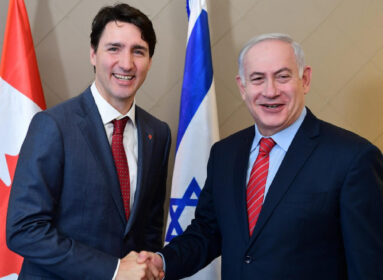
A CT artist puts a smile on the face of a wounded Israeli soldier…with a little help from his friends
By Cindy Mindell
NEWTOWN – It was the newspaper photo of Mordechai Yamin, the 21-year-old wounded Israeli sergeant sitting on a hospital bed, that caught Dr. Eitan Kilchevsky’s attention. Actually, it was what was behind Mordechai that made the impression. One of 12 Operation Protective Edge casualties featured in a Yedioth Ahronoth spread in September, Mordechai was pictured with two stuffed monkeys hanging in his hospital room.
Kilchevsky, an Israeli native and Newtown resident, is part of a group of friends in Newtown and its environs who support Israel through various projects and organizations. A fellow member is James Grashow, a Redding-based artist who had just installed “Corrugated Worlds: The Work of James Grashow” as the inaugural exhibition of the new Visual and Performing Arts Center at Western Connecticut State University in Danbury. Among the hundreds of corrugated-cardboard flowers, animals, and people comprising the work were 80 monkeys hanging from the ceiling and the walls. Kilchevsky attended the show’s opening in early October and it didn’t take long for the lightbulb to switch on.
“Eitan called me and said, ‘We should send Mordechai a monkey,’” Grashow recalls. “You can’t say no; it sounded too fantastic.”
The artist wanted to donate the artwork but “I told him we’re not going to take it as a donation; we’re going to buy it,” Kilchevsky says. “So we had to negotiate. At first, he wouldn’t take money, but he finally agreed, but not at the full price.”
Kilchevsky called the group of friends and had the money within two days. Grashow selected a monkey from the WestConn show and constructed a special shipping container.
But how would they make a monkey fly?
Kilchevsky, who is active in Friends of the Israel Defense Forces (FIDF), contacted the Westchester/Connecticut chapter to ask for suggestions. They could help, but it might take a while. Kilchevsky then called his friend Ofer, an El Al pilot who was about to fly from Los Angeles to Tel Aviv and wasn’t sure when he’d be back in the U.S. But just as he landed at Israel’s Ben Gurion Airport, he was asked to take a flight to Newark the next day.
“He told me, ‘I knew that there was a monkey waiting for me in New York,’ so he agreed to crowd his schedule a little and come back,” Kilchevsky says. The FIDF arranged to have a representative meet Ofer at the Tel Aviv airport. Kilchevsky drove the monkey to Ofer’s hotel room in New York, along with a gift certificate from the group as a ‘thank-you’ to the pilot.
“He took the box with him on the plane; I think it was probably the first monkey that flew first class on a 777,” Kilchevsky says.
A day after Ofer landed, Mordechai had a new monkey for his collection.
“The next thing I know, I got an email from Mordechai, who was adorable, holding up the cardboard monkey that two days ago was hanging in a show in WestConn,” Grashow says. “He sent a little recording [Grashow speaks in an Israeli accent]: ‘Jeemee, I lohve my mohnkee!’ I wrote back saying, ‘Even though this piece is made out of cardboard, I hope it strengthens the bonds between us.’ And I really do. It makes me feel wonderful to know that that monkey’s destiny was to be brought to Israel.”
The story doesn’t end there.
Ofer, an amateur guitarist, learned that Mordechai also shares that passion. A couple of days after the monkey arrived, the pilot visited the soldier and the two played their guitars together, with Mordechai using a special apparatus to make it easier for his injured hands. Ofer plans to get his friend, Israeli singer-guitarist David Broza, to work with Mordechai on hand-strengthening technique.
Mordechai is out of the hospital, returning for daily rehab sessions. In addition to his hand injuries, he has shrapnel lodged close to his brain that is probably inoperable. Kilshevsky has spoken with Mordechai several times and hopes to visit him in January.
Kilchevsky says that he will continue to find ways to help Israeli soldiers, through FIDF and other organizations, as well as independently.
“All of these soldiers are basically heroes in my eyes, really heroes – I’m not talking about basketball players or baseball players,” Kilchevsky says. “There are those soldiers who not only sacrificed during the war, but for many of them, the sacrifice continues: Mordechai and other soldiers like him are still struggling. He’s still not recovered, he needs to go to rehab, and even though he’s smiling in the pictures, his life probably will not be exactly the same because of his injuries.”
“Unfortunately, until peace comes and Israel doesn’t need a military, we will need to do projects for soldiers again,” he adds. “Whether it’s for people who are injured or who just serve and we can help them with higher education or make their time off-duty a little more pleasant at an R & R facility – the need will always be there.”
Meanwhile, Grashow says, “the Israeli monkey’s 79 brothers are cavorting around.” The artist takes particular delight from knowing that his little cardboard sculpture has done some good on both sides of the project.
“The way the idea formed and was executed had nothing to do with all the angst and violence and crap that goes on in the world,” he says. “It was just something that was joyous for everyone. And it’s helped bond our group here too. Everybody’s talking about it, wanting pictures of Mordechai, and feeling a connection to him.”
CAP: Sitting on his hospital bed, wounded IDF Sergeant Mordechai Yamin shows off the monkey he received from Kilchevsky and company.








 Southern New England Jewish Ledger
Southern New England Jewish Ledger















